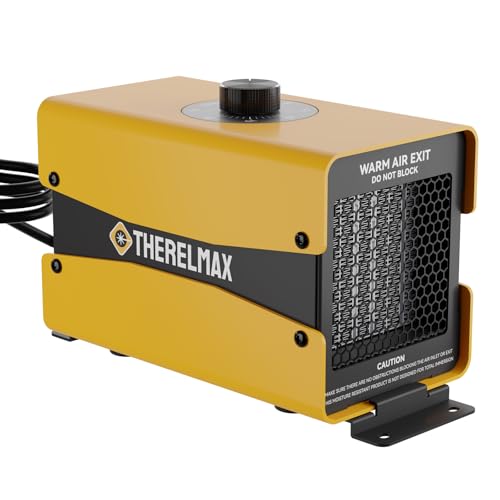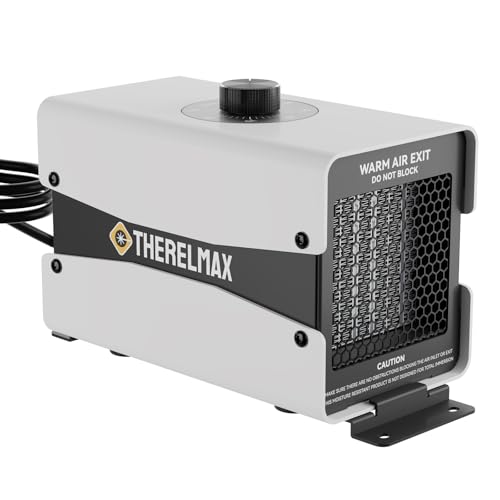Keeping your boat cabin, bilge, or engine compartment above freezing protects equipment and extends your season. Below is a quick comparison of five top marine heaters chosen for cabin and bilge freeze protection, portably heating small spaces, and marine-rated designs.
| Product | Type | Key Feature |
|---|---|---|
| Xtreme Heaters 400W Bilge Heater | Bilge/Engine Compartment | Self-regulating PTC, 58 CFM waterproof fan |
| Xtreme Heaters Boat, Cabin, & RV Heater | Portable Space Heater | Low profile, tip-over switch, draws air from top |
| THERELMAX HMA650 650W Heater | Bilge/Engine Compartment | Built-in adjustable thermostat, 3s fast heating |
| THERELMAX HMA800 800W Heater | Bilge/Engine Compartment | Higher wattage, adjustable thermostat for larger spaces |
| Haoguo 650W Bilge Heater | Bilge/Engine Compartment | Self-regulating PTC, 40 CFM waterproof fan |
Content Navigation
- Xtreme Heaters 400W Bilge Heater
- Xtreme Heaters Portable Cabin Heater
- THERELMAX HMA650 650W Heater
- THERELMAX HMA800 800W Heater
- Haoguo 650W Bilge Heater
- Buying Guide: Choosing The Right Marine Cabin Heater
- 1. Intended Location And Purpose
- 2. Wattage And Coverage
- 3. Thermostat And Control Type
- 4. Air Movement And Fan Specifications
- 5. Durability And Marine Ratings
- 6. Safety Features
- 7. Power Source And Electrical Considerations
- 8. Installation And Maintenance
- 9. Noise And Occupant Comfort
- 10. Comparison Perspectives
Xtreme Heaters 400W Bilge Heater

This bilge heater is designed for engine compartments, undercarriages, and small enclosed marine spaces. The unit uses a self-regulating PTC element that automatically activates around 40°F and cycles off near 55°F to maintain a protective temperature range. The anodized case and sealed electronics enhance durability for wet environments.
Key listed features include a smaller footprint with increased wattage, a 58 CFM waterproof fan for forced air circulation, and multi-directional mounting capability, including upside-down installation. This combination targets prevention of freezing for pumps, batteries, and hoses while providing continuous, maintenance-free operation.
Applications listed by the manufacturer include boats, RV underbellies, well houses, greenhouses, and campers. The self-regulating element reduces thermostat management and the waterproof fan supports marine exposure where moisture and splashing are concerns.
Xtreme Heaters Portable Cabin Heater

Call 888-896-7031 for Free Local HVAC Quotes – Compare and Save Today!
This portable heater is targeted toward small living spaces: cabins, boat cuddy spaces, and RV interiors. Its design draws air from the top, allowing placement flush against walls or on soft surfaces while maintaining airflow and safety. The unit emphasizes handheld portability and targeted comfort rather than large compartment freeze protection.
Manufacturer features highlight quiet operation, a low profile, and a stable base to reduce the risk of tipping. A built-in tip-over switch provides automatic shutoff if the heater is displaced. These features suit interior cabin use where occupant safety and noise are considerations.
Use cases include providing localized warmth while onboard or in a small cabin. It is intended for occupied spaces rather than continuous bilge protection, so installation considerations differ from dedicated bilge heaters.
THERELMAX HMA650 650W Heater

The THERELMAX HMA650 combines 650W PTC ceramic heating with a built-in adjustable thermostat covering a broad temperature range. The manufacturer recommends a setting near 46°F for engine compartment protection to prevent freezing while minimizing energy use, and the thermostat range offers flexibility for other applications.
Promoted benefits include fast 3-second heating response, making the device effective for quickly raising compartment air above freezing points. The product is marketed for bilges, RV bays, well houses, greenhouses, workshops, and lithium battery warming, indicating multi-use suitability.
Call 888-896-7031 for Free Local HVAC Quotes – Compare and Save Today!
Safety and winterizing advantages are noted: consistent compartment temperature reduces the risk of freeze-related damage to pumps, batteries, and lines. The adjustable thermostat returns manual control to the user for tailored protection depending on vessel size and conditions.
THERELMAX HMA800 800W Heater

The THERELMAX HMA800 ups the output to 800W for larger compartments or colder climates. Like the 650W model, it includes an adjustable thermostat with a 41°F–86°F range recommended for engine compartments near 46°F. Higher wattage supports more rapid temperature recovery and broader coverage.
Specific features include safe PTC ceramic technology and a waterproof fan for uniform heat distribution. The manufacturer notes suitability for boats, RVs, greenhouses, and service vehicles. The higher power rating makes it a fit for larger engine bays or cabins where a single heater must manage a bigger volume.
As with other marine-oriented heaters, the HMA800 is positioned as a winterization reduction tool, reducing mechanical freeze risk while helping maintain operational readiness in colder weather.
Haoguo 650W Bilge Heater

The Haoguo 650W bilge heater is tailored to enclosed engine compartments up to approximately 500 cubic feet. It features self-regulating PTC elements that start at 40°F and stop near 50°F, maintaining a safe low-temperature threshold for pumps, batteries, and plumbing.
Manufacturer notes include 10A overcurrent protection and a 40 CFM waterproof fan for continuous, uniform air movement. The product highlights simple installation, quiet operation, and suitability for boats where long-term unattended operation is required.
Use cases cited include protecting cabin pumps and batteries from freezing and maintaining dry bilge areas. Automatic PTC regulation reduces the need for ongoing monitoring while providing steady protective heat output.
Buying Guide: Choosing The Right Marine Cabin Heater
Selecting the appropriate marine heater depends on vessel size, target application (bilge, engine compartment, occupied cabin), power availability, and environmental exposure. Below are key considerations and comparison perspectives to guide selection.
Tips for Getting the Best HVAC Prices
- Prioritize Quality Over Cost
The most critical factor in any HVAC project is the quality of the installation. Don’t compromise on contractor expertise just to save money. - Check for Rebates
Always research current rebates and incentives — they can significantly reduce your overall cost. - Compare Multiple Quotes
Request at least three estimates before making your choice. You can click here to get three free quotes from local professionals. These quotes include available rebates and tax credits and automatically exclude unqualified contractors. - Negotiate Smartly
Once you've chosen a contractor, use the proven strategies from our guide — How Homeowners Can Negotiate with HVAC Dealers — to get the best possible final price.
1. Intended Location And Purpose
- Bilge/Engine Compartment: Choose heaters with waterproof fans, sealed electronics, and self-regulating PTC or thermostat controls that are rated for continuous unattended operation.
- Occupied Cabin: Prioritize safety features (tip-over switch, low noise), directed warmth, and units designed for interior spaces rather than continuous bilge protection.
- Multi-use: Adjustable thermostats add flexibility for greenhouses, workshops, and RV bays.
2. Wattage And Coverage
- Higher wattage (650–800W) offers faster heat-up and coverage for larger compartments. Consider compartment volume when evaluating wattage.
- Lower wattage or portable units are suitable for small cabins or spot heating occupied areas.
3. Thermostat And Control Type
- Self-regulating PTC elements maintain safe minimum temps without user intervention and are reliable for unattended freeze protection.
- Adjustable thermostats provide control for larger or multipurpose applications where exact setpoints are needed.
4. Air Movement And Fan Specifications
- Waterproof fans rated in CFM (e.g., 40–58 CFM) determine air circulation and distribution; higher CFM improves uniformity in complex engine bays.
- Consider positioning and direction of airflow—some units allow mounting in multiple orientations.
5. Durability And Marine Ratings
- Look for sealed electronics, anodized housings, corrosion-resistant materials, and waterproof fans designed for moist environments.
- Evaluate mounting options and the ability to operate upside down or in confined spaces typical of engine compartments.
6. Safety Features
- For cabin heaters, seek tip-over protection, overcurrent protection, and stable base designs.
- Bilge heaters should include thermal cutoffs, sealed electronics, and fan protection from splashing water.
7. Power Source And Electrical Considerations
- Confirm vessel electrical capacity and circuit protection; higher wattage heaters draw more current and may require dedicated circuits or shore power.
- Consider models with built-in overcurrent protection or consult an electrician to ensure safe installation and wiring.
8. Installation And Maintenance
- Assess mounting flexibility, access for wiring, and recommended clearances. Many marine heaters allow multiple orientations.
- Maintenance needs are generally low for PTC units, but periodic inspection of mounting, cabling, and fan operation reduces long-term risk.
9. Noise And Occupant Comfort
- If used in sleeping cabins, prioritize low-noise units or models designed for quiet operation to minimize disturbance.
- Fan-driven heaters produce some airflow noise; compare CFM and fan design if noise is a concern.
10. Comparison Perspectives
- Unattended Winterization: Self-regulating PTC bilge heaters with waterproof fans (Xtreme 400W, Haoguo 650W) are optimized for continuous protection without monitoring.
- Manual Control And Flexibility: Thermostat-equipped models (THERELMAX HMA650/HMA800) offer precise setpoints and are effective across different applications.
- Cabin Comfort: Portable interior heaters like the Xtreme Cabin & RV unit focus on occupant comfort, safety cutoffs, and placement versatility rather than unattended freeze protection.
- Larger Spaces: Choose higher wattage (800W) or multiple units for larger engine bays or combined compartments.
